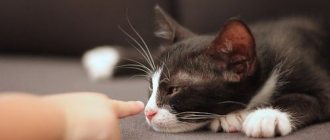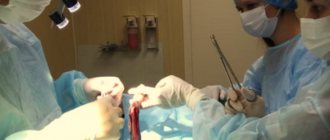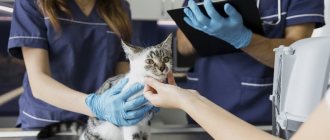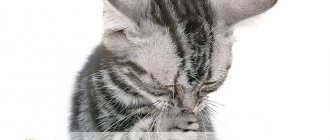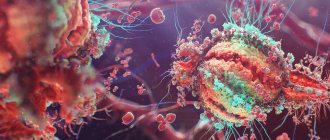There are diseases in cats that can frighten even the most experienced animal breeders and their owners. One of these diseases is convulsions in a cat that occur suddenly, and what to do, how not to get confused and panic at the sight of your pet convulsing, is what we will have to figure out in this article.
Convulsions in animals are very similar to an epileptic seizure in humans, and may even be accompanied by loss of consciousness. What are the causes of this condition in a cat?
Why does the animal run and nervously lick itself?
Licking is normal for cats. These clean animals are so sensitive to the cleanliness of their fur that they lick themselves at every opportunity: after eating, going to the toilet, or being touched by their owners. Moreover, by licking their fur coat, they calm down. Licking can be talked about as a normal phenomenon only when it is not fanatical in nature. Why does a kitten or adult cat run around the house and lick nervously?
The cat is stressed
These animals have a very vulnerable psyche. It doesn’t take much for a pet to lose its peace of mind. This can happen due to a trip in a car, a visit to the veterinarian, quarrels in the family, the appearance of a new four-legged inhabitant in the house, moving to another room, changing place of residence, etc. All cats experience stress differently. Some begin to run aimlessly around the apartment and fanatically lick the fur. Sometimes they do this so violently that in some areas of their bodies they become completely bald.
What symptoms will indicate the disease?
With further progression of the disease, the animal may refuse to eat. At the initial stages of development, the pathology does not cause any discomfort to the animal. Symptoms of gallstone disease in cats appear after the stone causes serious health problems. As the disease progresses, the following symptoms are noted:
- loss of appetite;
- weakness;
- vomit;
- increase in body temperature.
When eating food, the gallbladder begins to contract and push bile into the intestinal lumen. At this moment, the stones, which have sharp edges, dig into the walls of the organ. As a result, sharp pain occurs. The cat is rolling on the floor and screaming. If there are many stones, but their boundaries are even, there are no symptoms at the initial stages of the disease. As the disease progresses, the cat's mucous membranes turn yellow and the coat becomes rough.
Rules for taking anticonvulsants in veterinary medicine
When a veterinarian prescribes anticonvulsants, you must adhere to the established rules:
- The dose and schedule for taking the medicine must be strictly established; chaotic use is not allowed.
- You should not spontaneously stop treating your cat - this can lead to stronger seizures.
- If the drug runs out, you need to worry about buying a new package in advance. If the medicine is given on a prescription, you must notify your veterinarian.
- The product must be stored in a safe place, out of reach of animals or children.
- You need to consult a veterinarian about compatibility with other drugs, if there is a need for supplements.
Who usually experiences muscle cramps?
This trouble is familiar to everyone: men and women, children and the elderly, athletes and office workers. Only some people get to know her for natural reasons and rarely encounter her, while for others she becomes a frequent companion.
The risk group includes:
- children under 3 years of age who have experienced a rise in temperature above 38 degrees;
- elderly people suffering from vascular diseases and muscle atrophy;
- men engaged in heavy physical labor;
- athletes (football players, swimmers, runners);
- people who abuse alcohol and often experience hangovers;
Predisposes to muscle spasms and pregnancy. In mild cases, they are caused by a lack of vitamins due to changes in the body; in severe cases, they are caused by eclampsia.
The first cerebral symptoms of a tumor
When the second stage of the disease develops, the meninges are excited and intracranial pressure increases. As a result, cerebral changes occur.
The tumor puts pressure on the brain, affecting its functioning.
At this time, the treatment is still successful, but it takes longer and is more difficult. The symptoms of the second stage are no longer so easily confused with the symptoms of other diseases:
- sensitivity is lost in certain areas of the body;
- sudden dizziness occurs;
- muscles weaken, often on one side of the body;
- severe fatigue and drowsiness sets in;
- seeing double.
At the same time, my general health deteriorates and morning sickness continues. All this manifests itself in the patient regardless of what part of the brain the tumor is located in.
However, it is still possible to confuse the symptoms - they are approximately the same as with epilepsy, neuropathy or hypotension. So if you find yourself with these symptoms, do not rush to panic. But be sure to go to the doctor - the unknown has never been good for anyone. And such symptoms should not be joked about.
Consequences and complications
The pathology is quite dangerous and is one of the most common causes of child mortality. How favorable the prognosis will be depends on the severity of the baby’s condition and the Apgar indicator. If the score increases, the prognosis is considered favorableSource: Modern methods of treating neonatal asphyxia. Cherednikova E.N., Sherstnev D.G. Bulletin of Medical Internet Conferences, 2021. p.824.
However, with severe pathology, serious complications develop during the first year of life. Early consequences that may appear in the first few days after resuscitation include :
- respiratory arrest (the most common and dangerous complication);
- pulse failure;
- convulsions;
- cerebral edema;
- disruption of the urinary and digestive systems.
Later disorders include the following diagnoses:
- syndrome of increased excitability (hyperexcitability);
- increased intracerebral pressure (hypertension syndrome);
- lesions of the central nervous system (perinatal encephalopathy);
- disruptions in the functioning of the endocrine and vegetative-vascular systems (hypothalamic disorders).
With timely and competent medical intervention, as well as a high-quality recovery period, asphyxia of newborns may not have dangerous consequences in the future. Mild forms of asphyxia have almost no effect on the child; after the illness, his further development will proceed in the same way as in other babies.
Symptoms of seizures
Many people are probably familiar with the sensation that is caused by a muscle cramp, and at the same time there is a sharp pain. Cats experience similar sensations with muscle cramps. Visually, chaotic movements made by the paws are visible. Sometimes the opposite happens, and the pet lies on its side with tense paws curled under its stomach and clenched fingers.
The cat at this moment is very scared, screaming in pain, but does not allow the owner to touch him. During moments of convulsions, the cat’s pupils are dilated, and the whiskers are pressed tightly to the muzzle or become bristling.
If there are cramps in the hind legs, the pet may fall and the legs may be pulled in length. During a seizure, the cat may try to get up, but he will not be able to do it. But that rarely happens. Most often he is afraid to even move. In the most severe cases, the cat may urinate voluntarily and foam from the mouth. The animal does not recognize the owner, and therefore does not respond to his call. Sometimes the cat behaves aggressively.
But when the convulsions end, the pet, having calmed down, will behave as before. Although in some cases, for a short period of time, he may not find his usual places and may not even recognize his home.
Unfortunately, there are owners who, seeing their pet in this condition for the first time, do not rush to seek help from a skilled veterinarian, but wait until the seizures recur. This behavior is irresponsible, since seizures may indicate that the cat has developed a serious, and often life-threatening, illness, and when repeated seizures occur, time may already be lost.
It is very important not to make this mistake and bring your pet to the veterinarian even if after an attack of seizures he looks healthy and as cheerful as always.
Seizures in cats vary and may be accompanied by additional symptoms in different situations.
Your pet has seizures and twitching hind legs
Such convulsions occur in cases where there is a lack of a substance in the cat’s body or an excess of it. Similar conditions, with the exception of poisoning, for example, with pesticides, most often occur in elderly, pregnant, lactating, or malnourished animals. In more rare cases, such seizures may signal a stroke.
Cramps and drooling
Convulsions, which also cause drooling, may indicate the most terrible diagnosis for a cat - rabies. It is impossible to save a cat if it is already sick. He is immediately quarantined and restricted from any contact. In addition to cramps and drooling, it is necessary to carefully monitor other signs indicating the occurrence of the disease.
Cramps and foam at the mouth
Convulsions in a cat, accompanied by foam from the mouth, occur during an attack of epilepsy. But there are other reasons for this condition - kidney and liver diseases, hepatic encephalopathy, endotoxicosis, hypoglycemia.
Seizures of epilepsy with convulsions and foam at the mouth may indicate brain tumors, ischemic encephalopathy, and rarely post-traumatic or post-infarction conditions.
Cramps in a cat's hind legs while sleeping
Sometimes a cat has convulsions in his sleep. They can scare its owner. The pet is sleeping, but its eyelids, whiskers and lips are twitching, its paws, both front and back, tremble finely and often. You can hear the cat's loud meow or purr. In most cases
Such convulsions in a cat’s sleep are only a sign that he is having exciting dreams. But if he suddenly jumps up at the moment of convulsions during sleep, looks around restlessly, and then for a long time he cannot find a place for himself, then you need to sound the alarm and take the cat to the veterinarian.
Convulsions in a cat before death
In many cases, in cats, like in any other animal, the death throes are accompanied by convulsions. This condition may indicate approaching clinical death. Unfortunately, even if the course of treatment is carried out correctly, many diseases that are accompanied by seizures lead to the death of the cat. Therefore, if the veterinarian claims that your pet no longer has a single chance of recovery, you should not wait for the onset of painful and prolonged death throes. It is better not to cause him unnecessary suffering and, although it is very painful for the owner, to euthanize the animal.
Main signs and symptoms
The most obvious diagnostic sign is respiratory distress. It is this that subsequently leads to disruption of the cardiovascular system, weakening of the child’s muscle tone and reflexes.
Clinical manifestations of moderate asphyxia:
- lethargy, weakness;
- decreased motor activity;
- weak reactions;
- depressed reflexes;
- low-emotional cry;
- tachycardia;
- arrhythmic breathing, sometimes with wheezing;
- the skin is bluish, but can quickly turn pink.
The child's condition is considered moderate. During the first 2-3 days of life, he is in a state of increased excitability, which can be replaced by a syndrome of depression, weakness, and lethargy. The condition manifests itself as small tremors of the arms and legs, disturbed sleep, and weak reflexes.
In severe asphyxia, the clinical picture includes:
- lack of cry at birth;
- reflexes are severely depressed or sharply reduced;
- the skin is bluish, pale, with a “marble pattern”;
- breathing is shallow, arrhythmic and periodically absent;
- wheezing is heard in the lungs;
- the heartbeat is weak, dull;
- convulsions.
If acute severe asphyxia is successfully overcome, breathing normalizes within 2-3 days and reflexes are restored. Source: Fetal hypoxia and asphyxia of the newborn. Kuznetsov P.A., Kozlov P.V. General Medicine, 2021. p. 9-15.
First aid: owner actions
In such situations, a person’s self-control plays an important role. Timely measures taken will help save the life of a pet:
- During an attack, the cat must be carefully laid on a flat surface, which is covered with oilcloth or rags. At the same time, you cannot forcibly hold it, so as not to provoke unnecessary stress. You should not unclench your jaws, so as not to injure the animal.
During an attack, it is recommended to administer an anticonvulsant and analgesic to your pet. They do this by injection, and not by mouth: convulsions that seize the muscles of the larynx will not allow the cat to swallow the medicine, and it will simply choke.- A light massage will help ease the spasm. It is carried out on areas of the body affected by convulsions.
Even a small isolated attack is already a reason to urgently take your pet for examination. Convulsive muscle contractions don’t just happen. There needs to be a reason for this, and each of them is dangerous.
Seizures and convulsions: what are they?
These concepts are not shared in veterinary medicine. They mean an uncontrolled convulsive contraction of one or more muscles, which is usually accompanied by a sharp, aching pain. There are 2 types of seizures:
- spasms of striated or skeletal muscles that impair motor ability;
- spasms of smooth muscles - the vascular wall, disrupting the functions of various organs.
What can nocturnal epilepsy be confused with?
Sleep disorders similar to sleep epilepsy:
- Parasomnias (somnambulism, night terrors, waking up with confusion).
- Rhythmic motor acts during sleep (benign sleep myoclonus, involuntary movements of the limbs, bruxism = teeth grinding).
- Enuresis (bedwetting).
- Disturbance of the breathing rhythm during sleep (sleep apnea, including physiological apnea in children, obstructive apnea in adults).
- Movements during rapid eye movement sleep.
- Automatisms in sleep (swinging, yactation).
- Nocturnal “paralysis” (or nocturnal “intoxication”).
The importance of REM sleep in kittens
Kittens are able to dream while still inside the mother cat. Moreover, REM sleep provides neural stimulation, which contributes to the normal development of the brain and the entire nervous system of the embryo. The REM phase is extremely important for newborns and growing animals. Young animals experience dreams especially vividly. Kitty:
- can move its paws;
- beat the tail on the floor;
- roll over from side to side;
- move your ears and cheek muscles;
- breathe rapidly and meow.
Especially often, such violent reactions appear after outdoor games, stress or hunting experience. Running and tired, the baby may fall asleep in an unnatural position with his eyes half-open, which also should not cause concern. Firstly, kittens are like human babies and relax in their sleep without feeling discomfort, and secondly, the presence of a third eyelid in the corner of the eye helps protect the eyeball from drying out.
Features of the nervous system in kittens. The nervous system is formed simultaneously with the growth of the body, so unusual motor activity in kittens in the REM phase is completely normal.
If in adult animals the duration of REM sleep is 15-20 minutes, followed by a longer phase of slow-wave sleep, then in kittens up to six months the REM phase takes up 80% of the total rest time.
If the owner noted that the growing furry pet began to sleep more calmly and practically does not flinch in its sleep, then we can talk about the animal growing up and strengthening the nervous system. The period of stabilization of nervous functions is very individual and is determined by many factors, such as:
- Breed affiliation . In outbred cats, which generally mature faster, psychological maturation begins by 12 months, and representatives of large breeds, growing up to 2-2.5 years, demonstrate elements of childish behavior for quite a long time.
- Character . Temperamental and easily excitable animals require more time for the development of nervous processes than balanced and calm phlegmatic animals.
- Personal negative experiences and traumas . Stress can cause serious damage to the psyche. It has been proven that animals that have experienced fear and pain can return to this episode in their sleep, experiencing real nightmares.
Also watch the video why a cat twitches in its sleep:
Treatment at the Energy of Health clinic
Doctors at the Energy of Health clinic will always come to the aid of patients with intercostal neuralgia. We offer each client:
- a full examination with consultations with specialists for an accurate diagnosis;
- individual selection of treatment regimen;
- services of a qualified chiropractor;
- own exercise therapy room for the most effective and safe exercises;
- modern methods of physiotherapy;
- massotherapy;
- drug blockades for severe pain syndrome.
Regular observation by a neurologist after the acute period of the disease has subsided will help prevent recurrent attacks.
Prevention of newborn asphyxia
The expectant mother should be involved in the prevention of the pathological condition during pregnancy. To do this you should:
- attend routine gynecological consultations;
- adhere to the recommendations of the obstetrician-gynecologist;
- be sure to take vitamin complexes if prescribed by a doctor;
- monitor the condition of the fetus and placenta during routine ultrasound examinations;
- treat any diseases only under the supervision of a doctor, do not self-medicate;
- follow a daily routine, do not overload the body;
- get rid of bad habits;
- to walk outside.
In obstetrics, considerable attention is paid to the development of effective preventive methods that can reduce the risk of asphyxia during childbirth and during the first days of a baby’s life.
Sources:
- Modern methods of treating newborn asphyxia. Cherednikova E.N., Sherstnev D.G. Bulletin of Medical Internet Conferences, 2016. p.824
- Protocol for therapeutic hypothermia for children born with asphyxia. Ionov O.V., Balashova E.N., Kirtbaya A.R., Antonov A.G., Miroshnik E.V., Degtyarev D.N. Neonatology: News. Opinions. Training, 2014. p. 81-83
- Carrying out therapeutic hypothermia in newborns born with asphyxia. K. B. Zhubanysheva, Z. D. Beisembaeva, R. A. Maykupova, T. Sh. Mustafazade. Science of Life and Health, 2021. p. 60-67
- Asphyxia of newborns. Zhetpisova L.B. West Kazakhstan Medical Journal, 2011
- Fetal hypoxia and asphyxia of the newborn. Kuznetsov P.A., Kozlov P.V. General Medicine, 2021. p. 9-15
The information in this article is provided for reference purposes and does not replace advice from a qualified professional. Don't self-medicate! At the first signs of illness, you should consult a doctor.
Forms
There is no special classification of the disease. There are several separate forms depending on the mechanism of occurrence:
- radicular: associated with irritation of the spinal cord roots at the point of their exit from the spinal column;
- reflex: associated with overstrain of muscle fibers at the site of the nerve passage.
There is also a classification of neuralgia depending on:
- causes: primary (associated with damage or inflammation of the nerve itself) and secondary (due to other diseases);
- localization: unilateral and bilateral;
- course of the disease: acute and chronic.
Why do muscles cramp?
The reasons can be divided into two groups. The first includes those that do not have any underlying diseases. So, if the calf or gluteal muscles cramp in a dream, there is no physiological pathology in this. The seizure in this case is a parasomnia, that is, a phenomenon associated with sleep. Spasms that occur during increased physical activity also do not indicate an abnormality.
In other cases, such discomfort may be caused by:
- neurological disorders;
- compaction of muscle fibers against the background of physical inactivity;
- metabolic disorders;
- micronutrient deficiency;
- dehydration;
- poisoning (including cramps from a hangover).
There is also a disease called hypoparathyroidism. It is characterized by a convulsive syndrome that immediately affects muscle groups. This condition is caused by hypofunction of the parathyroid glands.
Preventive measures
Prevention will help you avoid problems related to your pet’s health:
- diet with the selection of balanced feeds;
immunization and deworming of the animal;- regular treatment against parasites;
- timely treatment of infectious diseases.
Preventive visits to the veterinarian 1-2 times a year will help to promptly identify and eliminate diseases of internal organs and systems.
Causes
In order to select the correct and high-quality treatment, a specialist at a veterinary emergency center must first determine the reasons for this behavior of the animal’s health condition.
Possible reasons :
- One of the reasons may be epilepsy, which is a complex neurological disease. This diagnosis is made if other causes have already been excluded. First of all, after a specialist from the veterinary center conducted a thorough examination, he took a urine and feces test. He also conducted neurological examinations, an examination of the back of the eye, and monitored the general condition of the pet over time.
- As a result of metabolic disorders, various pathologies of organs, their failures, hypokalemia, hypocalcemia, as well as toxoplasmosis.
- Poor heart function.
- Parasites present in the intestines can also be causes.
- A variety of infectious diseases that are caused by bacteria, viruses and fungi.
- Tumors.
- If the animal is poisoned by chemicals.
Diagnosis of suspected brain tumor
Even a general or biochemical blood test can indirectly indicate the presence of a tumor. However, if there is a suspicion of a neoplasm, more accurate tests and studies are prescribed:
- electroencephalography will show the presence of tumors and foci of convulsive activity of the cerebral cortex;
- MRI of the brain will show foci of inflammation, the condition of blood vessels and the smallest structural changes in the brain;
- A CT scan of the brain, especially with the use of contrast fluid, will help determine the boundaries of the lesion;
- analysis of cerebrospinal fluid - fluid from the ventricles of the brain - will show the amount of protein, cell composition and acidity;
- examination of the cerebrospinal fluid for the presence of cancer cells;
- A biopsy of the tumor will help determine whether it is benign or malignant.
Diagnostic methods
It is impossible to accurately determine cholecystitis based on clinical signs alone due to their lack of specificity. Therefore, diagnostic methods have been developed that are carried out in a clinical setting.
These include:
- collection of anamnestic data when the doctor determines the conditions of feeding, keeping and caring for the animal;
- examination, including percussion, auscultation, palpation, assessment of the condition of the mucous membranes and skin;
- general and biochemical blood test;
- Ultrasound of the abdominal organs.
To confirm the bacterial etiology of inflammation, an organ biopsy may be prescribed. This method is also used to determine the malignancy or benignity of an existing tumor. However, a biopsy is an invasive study that requires special equipment and highly qualified specialists. In addition, the preparation of histological material requires several days.
Note! Some reputable clinics now offer scintigraphy, which makes it possible to detect not only cholecystitis or cholelithiasis, but also to recognize malignant formations at the earliest stages of development.
Ultrasound for cholecystitis
During an ultrasound examination for cholecystitis, the following is revealed:
- increased echogenicity of the walls of the gallbladder, indicating their thickening;
- inflammation, focal or diffuse hyperplasia of the mucous membrane of the affected organ;
- heterogeneity of bile;
- expansion of the lumen of the bile duct;
- the presence of stones in the gallbladder.
Blood analysis
As a result of a biochemical blood test in the presence of cholecystitis, an increase in the level of:
- bilirubin more than 7.9 µm/l;
- cholesterol;
- alkaline phosphatase;
- liver transaminases ALT and AST;
- bile acids;
- glutamate dehydrase.
Acute inflammation is indicated by a significant increase in the number of leukocytes in the blood.
Seizures in a cat: how to provide first aid
The owner of a sick cat must be on alert, because the paroxysm begins suddenly. The main task is to avoid injury during convulsions. The cat is placed on the floor, turned on its side, and covered with soft cloth. In this position, her tongue will not stick into her larynx during a seizure. They sit down next to each other and place their hand on the pet’s head. The tip of a teaspoon is inserted between the teeth to prevent the kitty from biting her lip.
All observations about the pet's behavior during an attack are recorded in a diary to be provided to the veterinarian during the interview. Such information will help establish an accurate diagnosis and prescribe treatment. A video recording of an attack becomes valuable information for a diagnostician. You need to take care of your hands and wear gloves. A cat cannot control its behavior during a seizure.
Epileptic seizures
A distinctive feature of epileptic attacks is the fact that the animal is unconscious at this time. With all other types of seizures, consciousness is preserved. Clinicians distinguish 3 phases of the disease, the most severe of which is the seizure phase.
It is characterized by:
- clonic-tonic convulsions;
- profuse salivation and foam from the mouth;
- wheezing and shortness of breath;
- involuntary bowel movements and urination;
- tachycardia.
As the attack subsides, the animal regains consciousness, but for several minutes does not recognize the owners and does not orient itself in a familiar environment. After returning to normal, cats experience increased thirst and hunger.
During an epileptic attack, it is strictly forbidden to touch the animal or make loud noises, as this can prolong and intensify the seizure. You should carefully place soft objects around him to prevent injury, close the curtains and turn off running electrical appliances.
What veterinarians do
Veterinary clinic doctors know how to treat and what to do if a cat has seizures. The primary task is diagnosis, study of symptoms, analysis of information from the owner, which helps to promptly identify the causes and begin treatment. It is worth talking in detail about the cat’s diet, recent behavior, past injuries and illnesses.
© shutterstock
Primidone is prescribed to prevent causes and treatment. This is a remedy against epilepsy, also used for dogs. True, this medicine is toxic and dangerous for cats in large doses. Therefore, the drug is used in extreme cases or individually.
Other treatments are Phenobarbital and Pagliferal. Emergency medications help stop seizures immediately. Continuous use of drugs is prohibited. Residual inclusions of solutions accumulate in the blood, which leads to an overdose.
Taking medications requires compliance with a number of rules:
- The schedule cannot be changed at your own discretion. The dosage is selected according to the condition of the animal and is designed for a certain period of use. Otherwise, this may cause a critical failure of treatment and will not bring results.
- Abruptly stopping the medication can cause repeated seizures. This leads to exacerbation of other diseases and increased stress on the body.
- It is important to follow recommendations for storing medications for treatment. The medicine may deteriorate and cause toxicity to the body.
The veterinarian should be told if the cat is being given other preventative medications and why outside treatments are being given. Taking some substances can be dangerous when combined with potent drugs.
Treatment
Clinical recommendations for asphyxia include the provision of first aid to the newborn as a priority. This is the most important step, which, if carried out competently, reduces the severity of the consequences of the pathological condition and the risk of complications. The key goal of resuscitation measures for asphyxia is to achieve the highest possible Apgar score by 5-20 minutes of the newborn’s life.
The stages and principles of ABC resuscitation allow for consistent and effective resuscitation of a newborn born with asphyxia. Source: Carrying out therapeutic hypothermia in newborns born with asphyxia. K. B. Zhubanysheva, Z. D. Beisembaeva, R. A. Maykupova, T. Sh. Mustafazade. Science of Life and Health, 2021. p. 60-67:
- Principle A (“airway”) is to ensure a clear airway during the first stage of resuscitation. To do this, you need to create the correct position: tilt your head back, lower it 15 degrees. After this, suck out mucus and amniotic fluid from the nose, mouth, trachea, and lower respiratory tract.
- Principle B (“breath”) – create ventilation, provide breathing. To do this, a jet oxygen flow is created - artificial ventilation of the lungs is performed using a resuscitation bag. If the child does not cry, tactile stimulation is added: stroking along the back, patting the feet.
- Principle C (“cordial”) – restore heart function. Indirect cardiac massage helps with this. If necessary, adrenaline, glucose, hydrocortisone and other drugs are administered. In this case, the auxiliary ventilation from the previous stage cannot be stopped.
Care for a newborn child who has suffered asphyxia is carried out in a maternity hospital. Babies with a mild form are placed in a special tent with a high oxygen content. In cases of moderate or severe asphyxia, infants are placed in an incubator - a special box where oxygen is supplied. If necessary, the airways are re-cleaned and freed from mucus.
The scheme of further treatment, recovery and care is determined by the attending physician. General care recommendations include:
- maintaining normal body temperature, blood pressure, heart rate;
- creating maximum comfort: optimal ambient temperature, comfortable position;
- carrying out respiratory therapy;
- conducting infusion therapy - administering fluid to meet needs Source: Protocol for therapeutic hypothermia for children born with asphyxia. Ionov O.V., Balashova E.N., Kirtbaya A.R., Antonov A.G., Miroshnik E.V., Degtyarev D.N. Neonatology: News. Opinions. Training, 2014. p. 81-83.
During rehabilitation, regular monitoring :
- baby's weight (twice a day);
- neurological and somatic status;
- volume of fluid consumed;
- nutrition composition;
- basic vital signs: pulse, blood pressure, saturation, respiratory rate;
- laboratory characteristics of blood, urine;
- X-rays of the chest, abdominal cavity;
- ultrasound examination of the abdominal cavity;
- neurosonography;
- electrocardiograms, echocardiograms.
After discharge, the baby should be regularly monitored by a pediatrician or neurologist.
Why do muscles cramp in pregnant women?
Carrying a child leads to significant changes in the body. In particular, metabolism is rebuilt. As a result, many expectant mothers are faced with magnesium deficiency, which is why cramps appear.
Pregnant women's legs are subject to greater stress due to weight gain. Hence the involuntary muscle contractions that occur in the evenings and at night. They can also be triggered by varicose veins, which often accompany hormonal changes.
Pregnant women often complain about back pain. The lumbar spine is under constant tension, forced to bend under the pressure of the uterus, so such sensations are normal. Therefore, expectant mothers are recommended to lie on their side to relieve the load on the spine.
What to do if a muscle is severely cramped
It is not always possible to easily endure such an attack by limiting yourself to rubbing the affected area. The pain can be unbearable. It can be removed with a sharp impulse.
For cramps due to a hangover, the patient should be placed in a horizontal position and the legs should be raised to reduce blood flow to the extremities. At the same time, it is important to make sure that we are not talking about an epileptic attack (they are not uncommon in alcohol intoxication).
In older people, involuntary muscle contractions are often a warning sign of stroke. Convulsions may give way to paralysis. Timely treatment is important here, so it is better to call an ambulance immediately.

